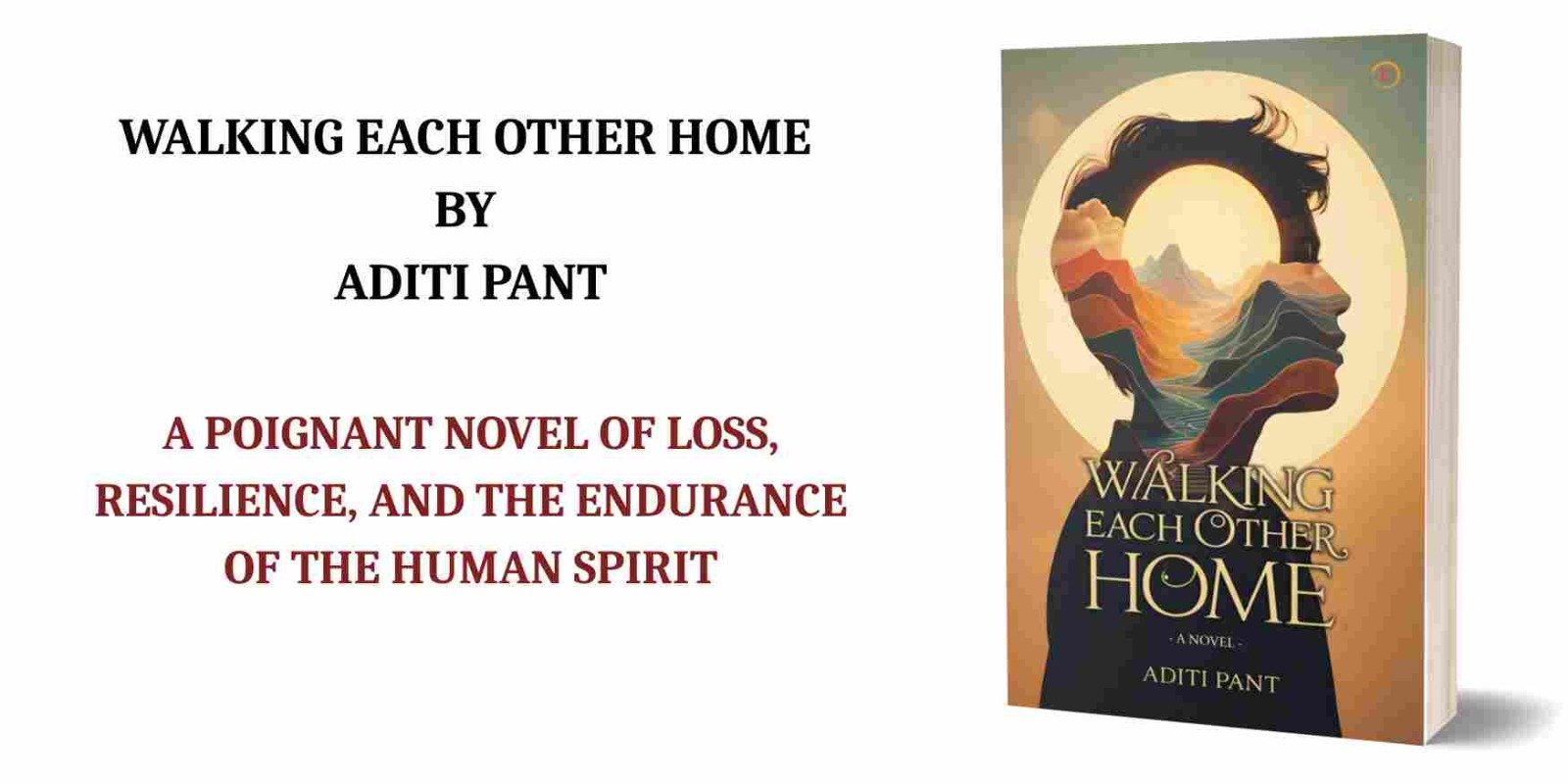- Book Title: Walking Each Other Home – A Novel
- ISBN: 9789373351148
- Author: Aditi Pant
Introduction
Some books are not just stories — they are experiences, emotional journeys that make us reflect on life, memory, and the strength of the human spirit. Walking Each Other Home by Aditi Pant is such a book. Published in 2025, this novel is a piece of biographical fiction inspired by the life of the author’s father, Mahanand Paliwal (Mohan). Through the character of Mohan, Pant tells a story that is both deeply personal and universally relatable.
It is set in the late 1940s and follows Mohan’s difficult childhood in the Kumaon hills of Uttarakhand, where he faces the loss of his mother at just two months old and then the emotional abandonment of his father. Instead of portraying dramatic victories, the book focuses on quiet endurance, resilience, and the subtle beauty of survival. It is a story of grief, poverty, culture, tradition, and the hope that allows people to move forward even when life feels unbearably heavy.
Pant’s writing style is poetic and meditative, weaving together landscape, memory, and folklore into a narrative that feels almost like oral storytelling. Her words create a rhythm, where the mountains, rivers, and forests of Kumaon become living presences, shaping Mohan’s journey.
This review explores the novel in detail — retelling the story, analyzing its themes, appreciating its style, and reflecting on its impact.
Story Overview
The book opens with an Author’s Note, where Pant explains that this is a fictionalized version of her father’s life. Immediately, we are prepared for a story that is not just about one boy, but about an entire generation of children who grew up in poverty and hardship in rural India.
The Prologue sets the tone beautifully: the mountains whisper, stories appear and disappear like mist, and the reader is invited to listen. This is not just Mohan’s story; it is also a meditation on how stories survive through memory, culture, and tradition.
From the first chapters, we are introduced to Mohan’s early loss. His mother, Madhuli, dies when he is just two months old, leaving behind not only an infant son but also a broken household. His father, devastated, withdraws into silence and eventually abandons the family, leaving Mohan and his siblings to the care of extended relatives. The absence of parental love becomes a defining feature of Mohan’s childhood.
The rest of the novel follows Mohan’s journey from neglected infant to a boy navigating loss, survival, and eventually the slow carving of meaning in his life. Along the way, we see his sister Didi and brother Daju taking on adult responsibilities far too early, the cruelty and indifference of relatives, the cultural traditions of Kumaon, and Mohan’s quiet, inner resilience.
The book does not follow a dramatic arc in the traditional sense. Instead, it is structured like a series of memories and reflections, with chapter titles like “This is What I Don’t Remember,” “Scars of Memories,” “God Knows Where It Hurts,” and “Seeing What is Invisible to Others.” These suggest the fragmented, tender nature of memory — the story is told not as a straight line but as an emotional landscape.
Major Themes
1. Loss and Absence
The central theme of the novel is loss. Mohan’s mother’s death leaves a wound that never truly heals. Pant describes how a home without a mother feels incomplete, like a puzzle with missing pieces. This absence shapes not just Mohan’s life but the lives of his siblings and father as well.
2. Childhood and Survival
The novel explores how children survive in the absence of parental care. Didi takes on responsibilities far beyond her age, Daju withdraws into silence, and Mohan himself learns to endure hunger, neglect, and loneliness. This survival is not heroic but quiet, often invisible — yet it is deeply moving.
3. Family and Abandonment
The book shows how families can fracture under grief. Mohan’s father’s abandonment is portrayed not with anger but with a kind of tragic inevitability. Relatives step in, but often with reluctance, showing how children can become burdens in extended households.
4. Nature as Companion and Teacher
The Kumaon landscape is not just a setting — it is a character. The mountains, rivers, forests, and fields mirror Mohan’s emotions. Sometimes they comfort, sometimes they challenge. Folk songs, festivals, and rituals tied to the land also enrich the narrative.
5. Resilience and Hope
Despite everything, the novel is ultimately about resilience. Mohan grows like the rhododendron, stubbornly blooming even in harsh conditions. Hope is not loud or dramatic here — it is quiet, stubborn, and beautiful.
Writing Style
Pant’s style is lyrical, poetic, and rooted in cultural detail. She blends prose with imagery, memory, and folk tradition. The rhythm of her sentences often mimics the rhythms of oral storytelling. She also uses repetition to create a sense of echoes, like the echoes of mountains and memories.
One of the most striking aspects of her writing is the way she describes ordinary details with tenderness — the smell of boiling milk, the feel of a mother’s ghagra, the sound of folk songs. These details create a sensory richness that pulls the reader into Mohan’s world.
Characters
- Mohan: The heart of the story. Sensitive, lonely, yet quietly strong. His journey is not about achieving greatness but about surviving with dignity.
- Madhuli (Mother): Though she dies early, her presence lingers through her name, her absence, and the memories of others. She represents nurturing and loss.
- Father: A tragic figure who abandons his children after his wife’s death. His silence and withdrawal show how grief can break a person.
- Didi: Mohan’s elder sister, who sacrifices her childhood to care for others. Her marriage and departure mark another loss for Mohan.
- Daju: The elder brother, quieter than Didi, who also shoulders responsibility but in a more withdrawn way.
- Nani: A grandmotherly figure who steps in to care for Mohan at a crucial moment. She represents tradition, storytelling, and a fragile form of care.
- Chacha and Chachi: Relatives who reluctantly take Mohan in. Their care is mixed with neglect and occasional cruelty.
Chapter Highlights
The book has over 40 short chapters, each capturing a moment, memory, or reflection. A few highlights:
- “This is What I Don’t Remember”: Introduces Mohan’s family life before his mother’s death, through stories told by others, since he was too young to remember.
- “My Mother’s Name”: A meditation on the meanings of the name “Madhuli” and the absence it represents.
- “It’s Hard to Leave Only Until You Leave”: Describes the father’s departure, a heartbreaking moment when abandonment becomes real.
- “Not All That is Lost is Found”: Mohan nearly dies of neglect as a baby until Nani steps in to save him.
- “Scars of Memories”: Shows how siblings are forced to act like adults, doing chores and carrying responsibilities.
- “Seeing What is Invisible to Others”: Mohan’s struggles at school, where he feels out of place and invisible.
- “Family Ties”: Captures the cruelty of relatives and Mohan’s sense of being unwanted.
- “Home is for Returning”: Later in life, Mohan reflects on the idea of home — what it means to lose it, and what it means to build one again.
Each chapter is like a vignette, contributing to the larger picture of Mohan’s life.
Cultural Richness
The book is also a window into Kumaoni culture — its folk songs, rituals, festivals, food, and daily life. Pant beautifully describes traditions like Rajula Malushahi folk songs, the rituals of weddings and funerals, and even the daily chores of mountain life. This cultural grounding gives the story authenticity and depth.
Emotional Impact
Reading Walking Each Other Home is a tender, emotional experience. The book does not manipulate emotions with melodrama but instead creates quiet sadness and quiet hope. It makes readers reflect on their own families, their own absences and presences, and the universal search for meaning.
Evaluation
Strengths:
- Poetic, lyrical writing
- Deep cultural grounding
- Honest portrayal of grief and survival
- Emotional depth without melodrama
Possible Weaknesses:
- The slow, reflective style may feel heavy for readers who prefer fast plots
- The fragmented, memory-like structure may confuse those expecting linear storytelling
But overall, these are not flaws — they are deliberate choices that make the book what it is.
Conclusion
Walking Each Other Home by Aditi Pant is a deeply moving novel about loss, resilience, and the quiet dignity of survival. By fictionalizing her father’s life, Pant creates not just a personal story but also a universal meditation on childhood, family, and the endurance of the human spirit.
It is a book that lingers — not because of dramatic twists, but because of its tender honesty and poetic beauty. For readers interested in stories of memory, culture, and resilience, it is a must-read.
In the end, the title says it all: life is a journey where we carry our burdens, but also where we walk each other home.
Buy This Book From Amazon: Buy Now



